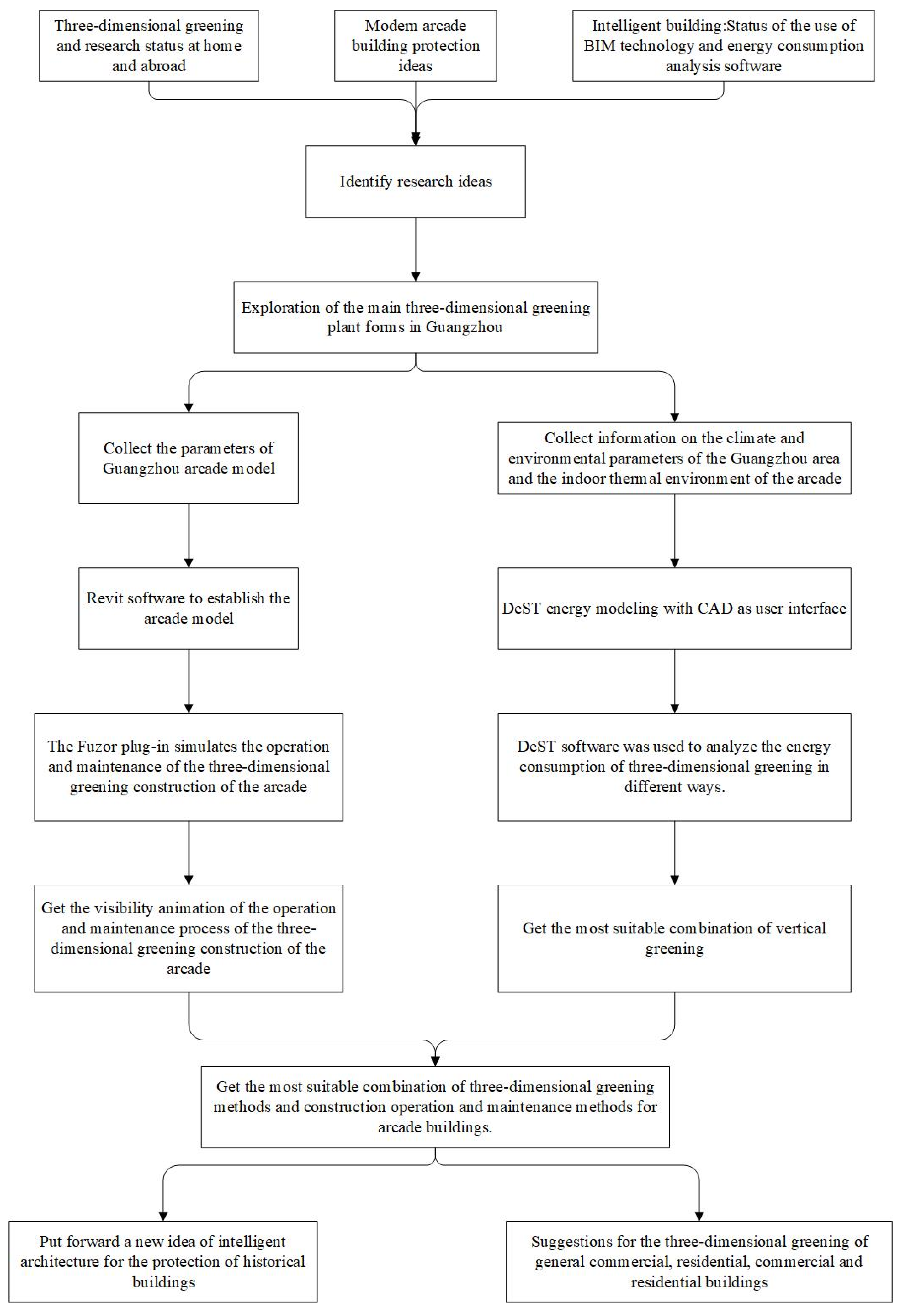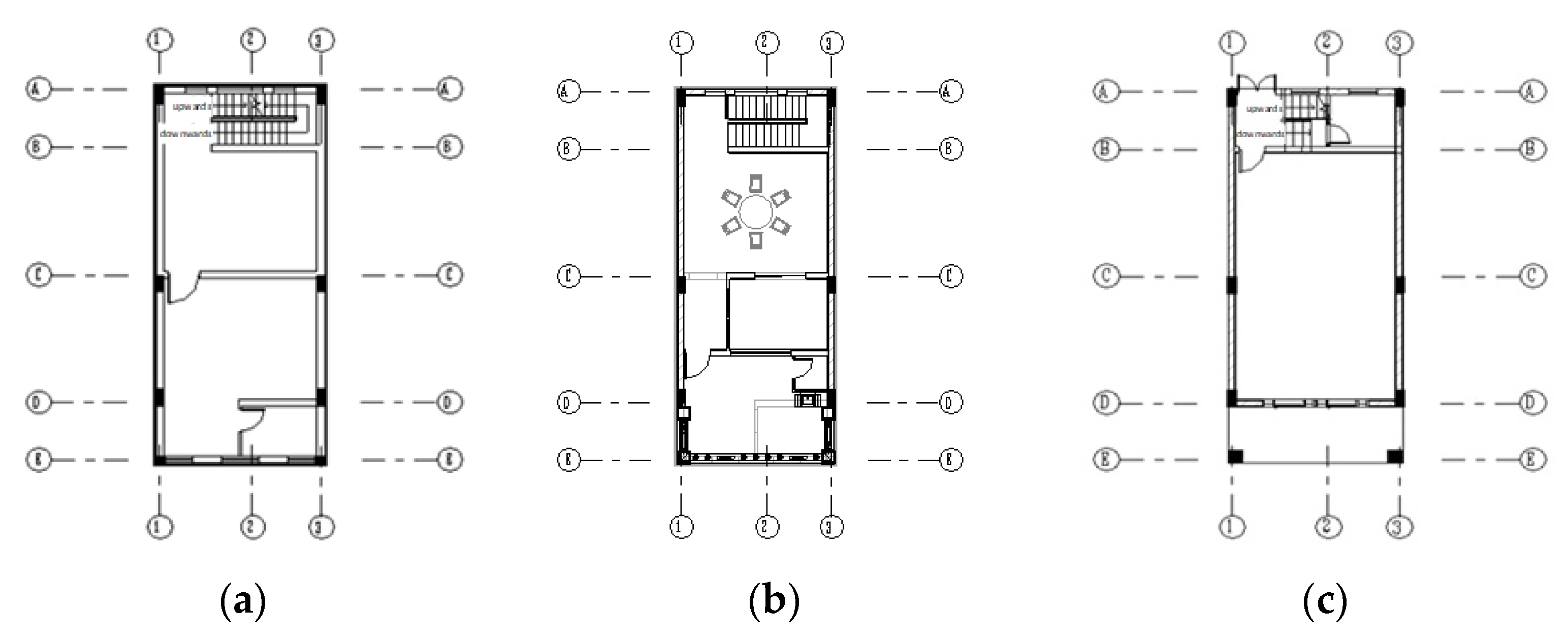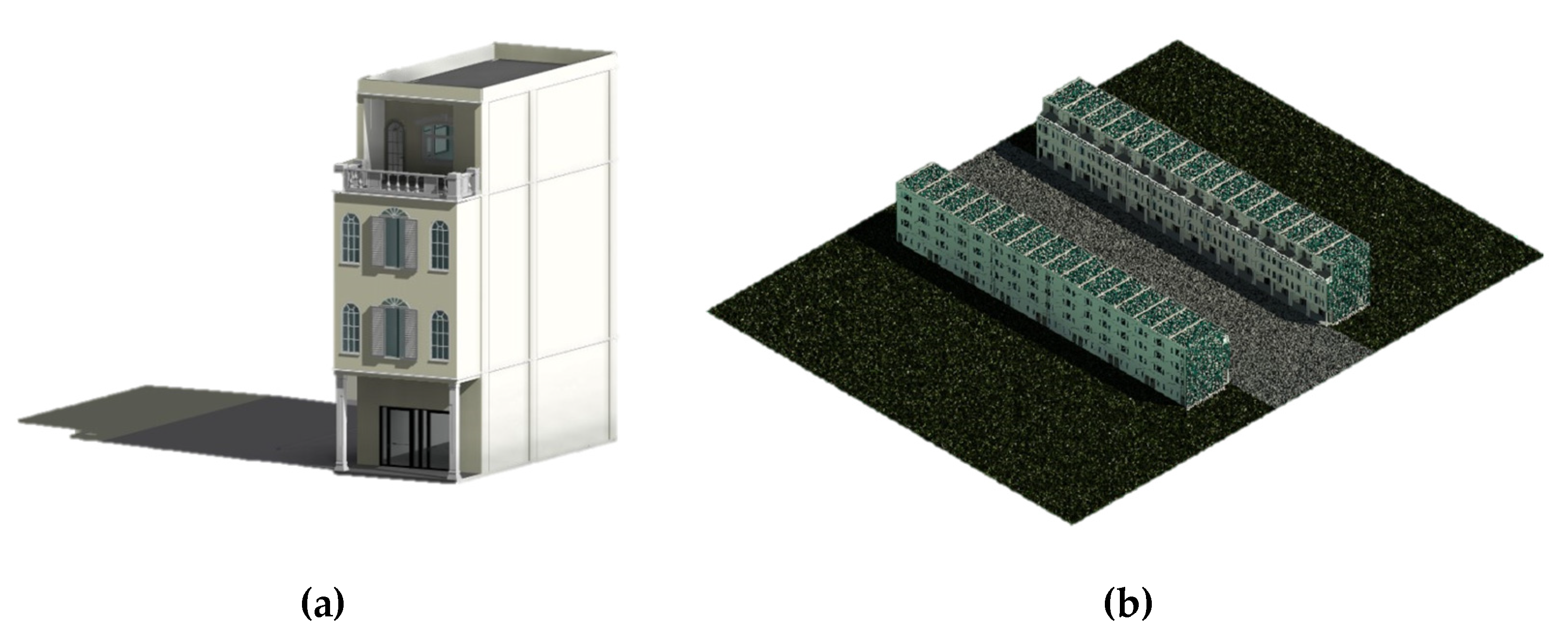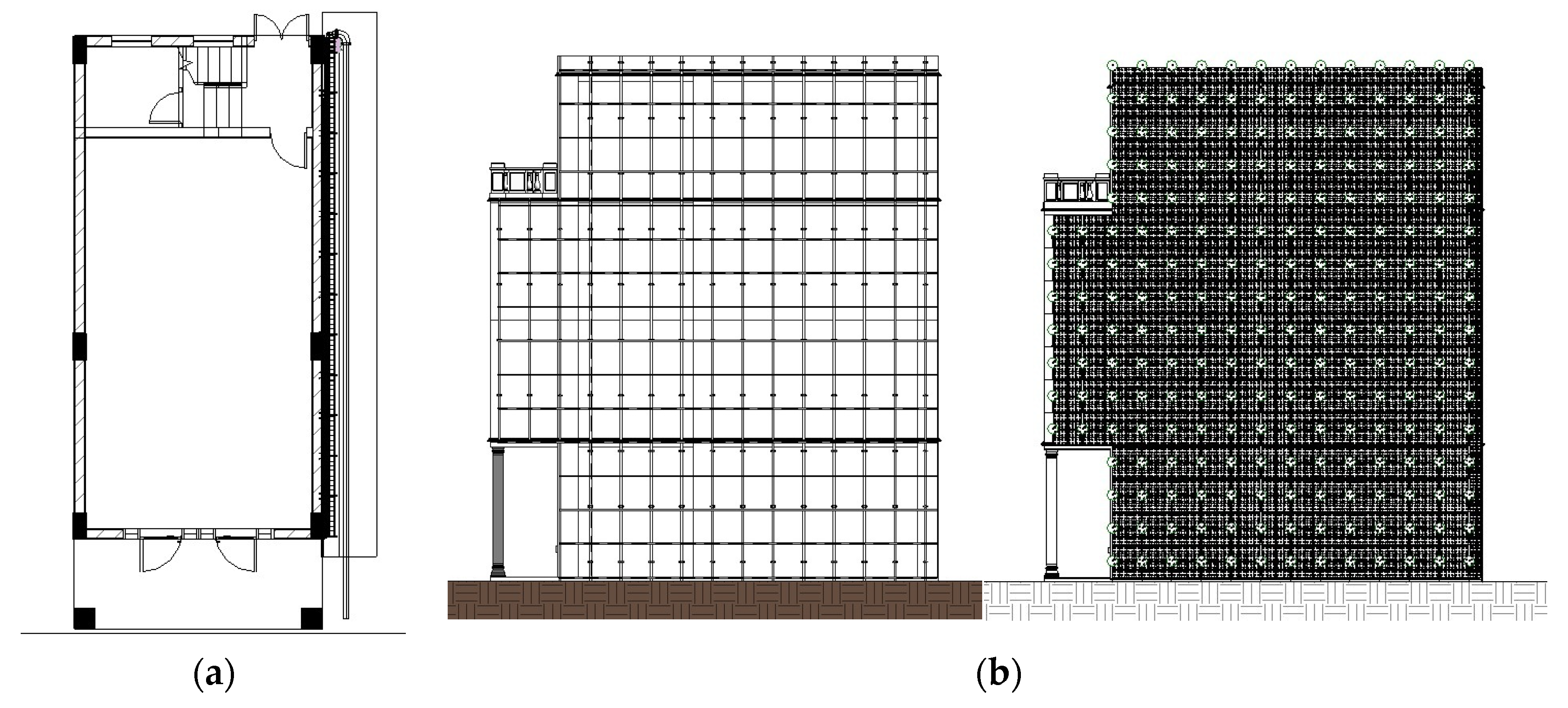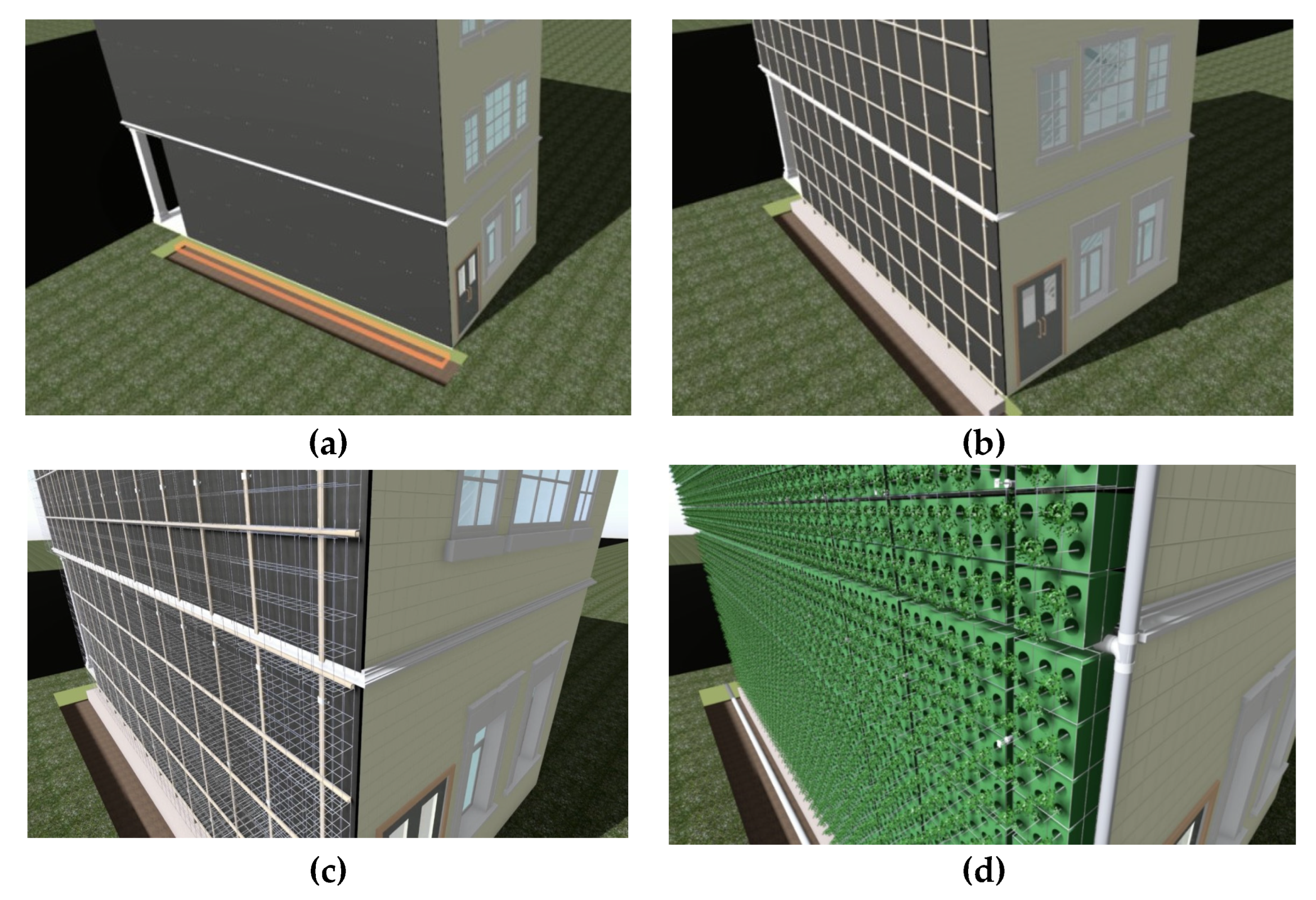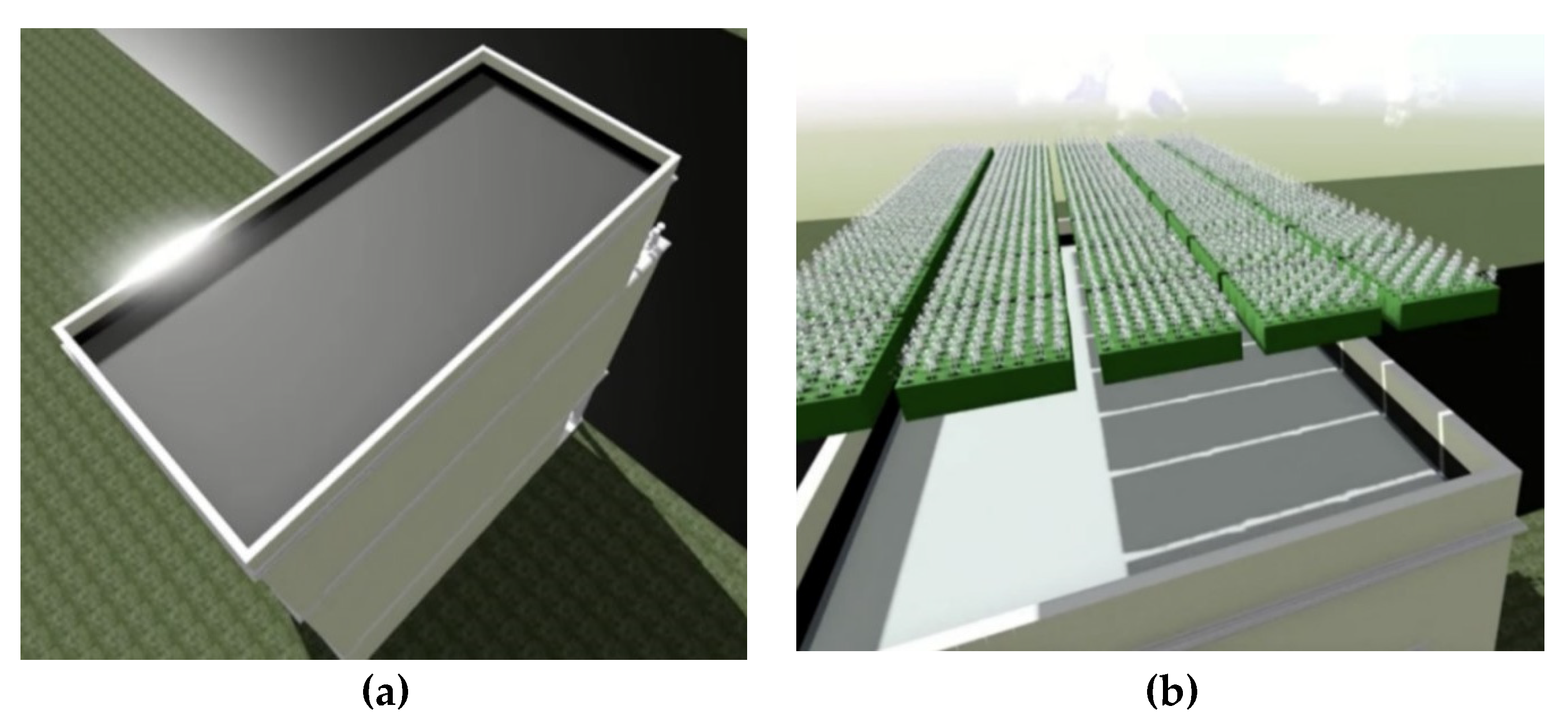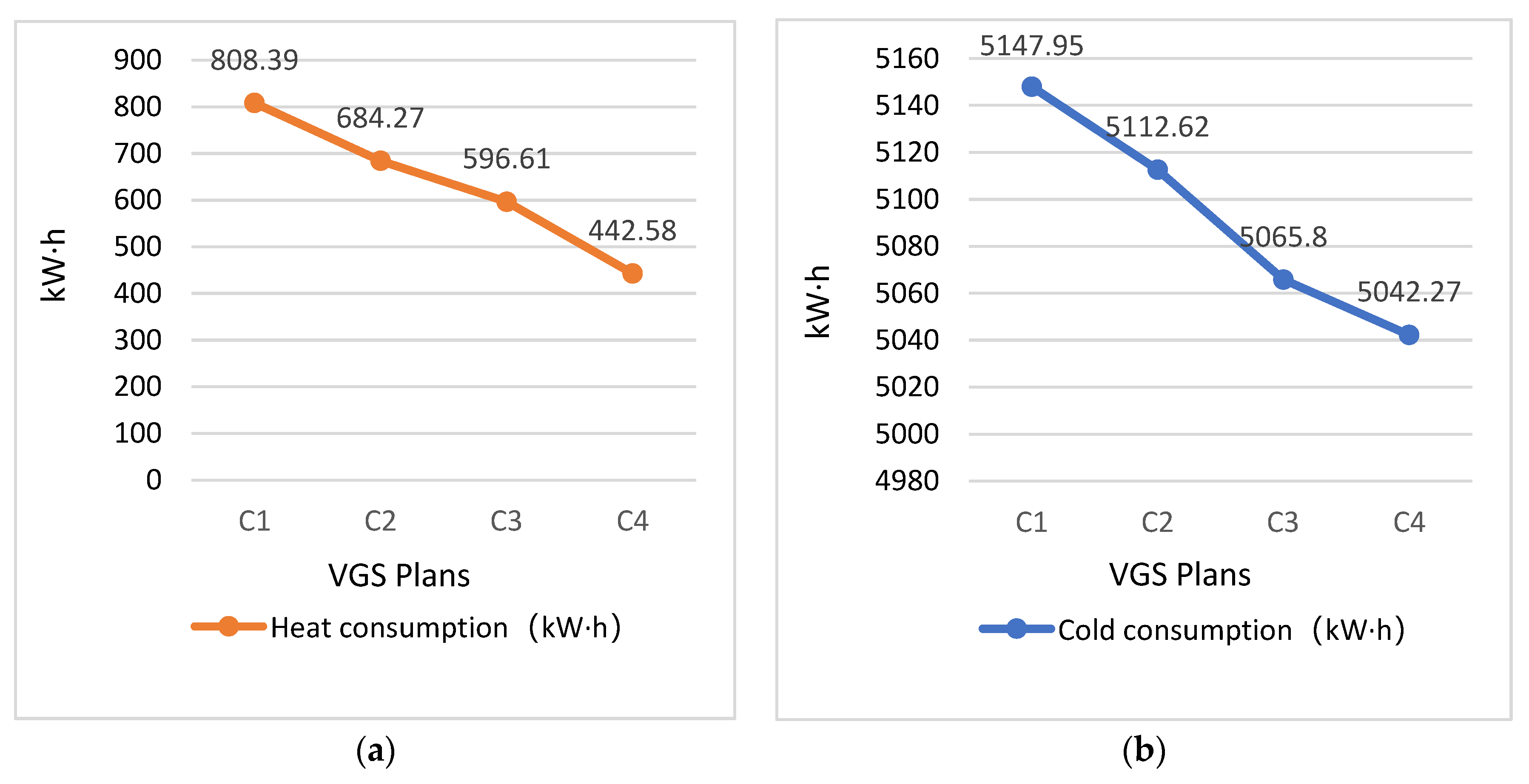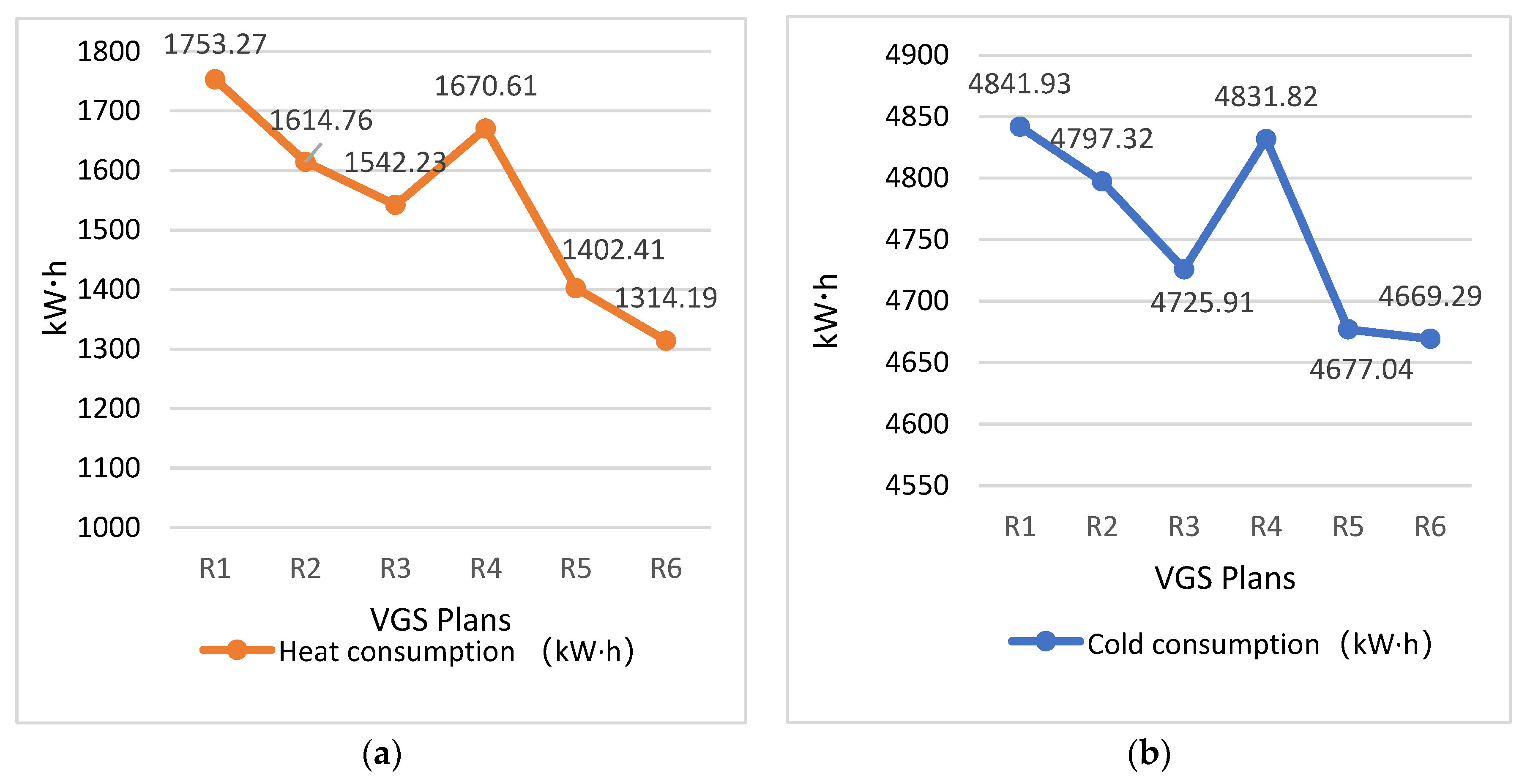1. Introduction
With recent industrialization, cities are increasingly becoming the habitat of choice. According to statistics, cities house more than half of the world’s population and will grow rapidly at 2.6% per year [
1]. The replacement of green vegetation cover by artificially hardened surfaces in the urban fabric is considered to be the leading cause of the Urban Heat Island (UHI) [
2], and the “canyons” formed by high-density buildings primarily affect the ventilation of the inner city, leading to heat accumulation and increasing the regional heat risk [
3]. The temperature difference between cities and surrounding suburban areas can be as high as 8 °C [
4], and every 1 °C increases in daily maximum temperature increases electricity demand by 2–4%, with the use of cooling facilities such as air conditioners accounting for 5–10% of peak urban electricity demand [
5]. According to the World Health Organization, cities are responsible for 60–80% of global energy consumption [
6], with the building sector accounting for approximately 40% of the world’s total energy consumption [
7]. Nearly half of building energy is consumed by heating, ventilation, and air conditioning systems [
8]. Therefore, cities have considerable potential to reduce energy consumption and mitigate UHIs, and it is crucial to plan and design sustainable cities in the context of sustainable development [
9].
Many urban areas are located in coastal areas and are highly vulnerable to hydrometeorological and risk hazards, especially storms and floods. The International Sustainable Development Goals (ISDGs), adopted in 2015, propose to “make cities and human settlements inclusive, safe, resilient and sustainable” [
10] and regard Disaster Risk Management (DRM) as a critical issue for sustainable urban development in the next 20 years [
11]. Among these features of the new urban policy, resilience deserves special consideration. Strengthening cities’ resilience is particularly important for coping with, recovering from, and adapting to multiple environmental and climate change hazards. Croese et al. [
12] reviewed the resilience strategies that members of the 100 Resilient Cities (100RC) developed. They demonstrated that 100RC cities are increasingly aligning their resilience efforts with global development policies such as the Sustainable Development Goals (SDGs) and others. Urban resilience relies on the natural, social, political, human, economic, and built sectors, with the built sector being an essential part of the equation. Among innovative and environmentally friendly solutions, Vertical Greening Systems (VGS) are an essential strategy to address sustainable urban development and increase urban resilience. Incorporating greenery into building façade systems can reduce greenhouse gas emissions [
13], thus effectively reducing air temperature in urban areas and helping to mitigate the urban heat island effect [
5,
14,
15]. Urban heat has become vital management of many cities in tropical and subtropical regions [
16]. In addition to the construction of new green buildings, the existing building stock should be considered, and the potential of vertical zones in urban areas is considered enormous. Urban planning and development must view the results of dealing with the renovation of long-term architectural heritage and excessive building culture. Especially in countries where the building stock is more than 50 years old, more effort should be invested in developing appropriate policies to renovate existing building stock [
17].
The existing residential building area in China is about 60 billion square meters. As of December 2020, the size of existing residential buildings certified as green buildings through retrofitting is only 2.902 million square meters [
18], accounting for 0.06% of the total area, which needs to be revised. Therefore, there is a need for green retrofitting of existing buildings. The Guangdong–Hong Kong–Macao Greater Bay Area (GBA) is the world’s third-largest city cluster economy, with a nominal GDP of USD 1.64 trillion in 2018 [
19]. Guangzhou is one of the key cities in the GBA and one of the most densely populated cities in China. Guangzhou is located in a subtropical region, and its climate characteristics are ideal for creating VGS. The renovation of the arcade-housing, an old building in Guangzhou, China, provides a suitable opportunity to increase the green area in Guangzhou. The Cavalcade is an exterior corridor-style building with distinctive features. The original timeline goes back about 2500 years to the construction of the Parthenon, a unique and iconic building in ancient Greece, which was one of the main buildings of the Acropolis. The building could shield itself from the hot sun, and later Asian features were gradually incorporated into the European-style cavalcade. This form of architecture was progressively introduced to Southeast Asia as the region and time changed.
This study took the VGS in Guangzhou, China, as a case study, analyzed the most suitable three-dimensional greening methods and plants for the arcade-housing in Guangzhou, and clarified the structural characteristics of the arcade-housing as well as the features and parameters of the arcade-housing model. Digital Twin (DT) was applied to conduct construction, installation, and energy consumption simulation analysis to transform the vertical greening system and to analyze the feasibility and energy consumption of the designed vertical greening system. Firstly, Revit software and the Fuzor plug-in were used to simulate the construction, irrigation, and fertilization process of vertical wall greening and roof greening in the stereoscopic greening of typical street-facing arch villas in southern China. Then, based on collecting related parameters of the Guangzhou climate environment, different vertical greening transformation schemes were designed according to the direction of the facade wall. At the same time, the DeST software was used to simulate and analyze the heat consumption and cooling consumption of the VGS façade, ground-floor storerooms, and the top-floor residential spaces in the arcade-housing. Finally, considering the cost and energy saving effect, the best transformation scheme of a vertical greening system of traditional riding buildings was obtained.
3. DT-Based Building Modeling Process for Street-Level Arcade-Housings
According to the façade characteristics of the exterior corridor type building and the building body component size and material, the street-level arcade-housing model is established through Revit software. Revit is a software established explicitly for building information models. It can achieve fine control of the setting and placement of the internal and external dimensions of the object. This software provides a free-form modeling and parametric design tool with a simple operation, which can carry out design analysis at the initial stage of development, freely draw sketches, and quickly establish 3D models. Meanwhile, by analyzing the construction of modular VGS forms, irrigation, and fertilization methods, the building is simulated around the model of the arcade-housing to make a visualization of the virtual construction of VGS of the arcade-housing. Combined with the analysis of DeST energy consumption simulation software, the meteorological parameters of the Guangzhou area, indoor air conditioning simulation parameters, VGS thermal parameters, and other parameters are collected and set. A typical top-floor residential room and a ground-floor storage room are examples. Their building energy consumption is modeled and analyzed for combinations of green roofs and vertical wall green parameters, which provide a basis for the optimal variety of green forms for rooftop buildings.
Figure 1 illustrates the flow chart for this study.
3.1. Basic Parameters of the Model
The height of the arcade-housing in this study consists of the gallery column, the first, second and third floors, and the top parapet. The height of the corridor is 4 m, the height of the first, second and third stories is 3.6 m and the height of the parapet wall at the top storey is 1.2 m. The width of each story is 4 m and the length is 30 m. The rider body’s building structure components are mainly arched windows, balconies, and commercial signboards. The patio is a necessary facility for the cavalry building. As the second and third-floor indoor space of the cavalry building expands, the balcony improves the indoor environment and creates a living room for people to rest and take a fantastic break in their daily life. This model is a recessed, solid-type balcony. The balcony railings are brick. The bottommost column is a load-bearing structure composed of columns and beams, and it has a remarkable style of intermingling inside and outside. The crossbeam is under the commercial sign on the second floor and is 0.4 m in height. The beams and columns are interconnected by a small structure that replaces the traditional Chinese architectural decorative design.
The door of the ground floor store, which has the same width as the opening and the same height as the net height of the ground floor, consists of two parts. The upper part is light and decorated with wooden pillars, which play the role of ventilation. The lower part is a wooden door, generally consisting of five groups of small doors. The left and right wooden doors are 0.3 m wide, generally not open, and their use mainly lies in pasting decorative and characteristic couplets. The middle three doors are 0.6 m wide and consist of two doors. In the lower right corner of the door, there is a 0.8-meter-high brick platform, the use of which is to conduct the placement and display of goods.
3.2. DT-Based Simulation of VGS Construction Operation and Maintenance for Street-Level Cavalry Buildings
3.2.1. Building Model Establishment
A model of the typical street arcade-housing model is created in Revit software. Firstly, the floor elevation is set under the Revit building panel, and the reference plan and axis network are drawn. The wall width is then set to 200 mm, and the material is a grey sand brick wall with an internal and external surface layer of cement mortar. Afterward, the borders are drawn, and the components such as doors, windows, stairs, and railings are added.
Figure 2 shows the model’s first, second, third, and fourth-floor plans. Generally, the arcade-houses are in opposing rows, with roads between the two rows of arcade-houses forming a section of the commercial and residential community. In addition, the replication and symmetry operations conducted in Revit, after creating a separate model of a riding tower, ultimately present a complete profile in the form of an arcade block.
Figure 3 shows the model of a single unit of arcade-housing and the shape of the arcade block in Revit.
3.2.2. Simulation of VGS Construction Operation and Maintenance
First of all, the VGS form of the single arcade-housing facade is an example, and the simulation of construction and irrigation is performed through plug-ins on the floor. In the study of VGS, this paper takes the single arcade-house as the object of study, which is the end point of rows of buildings, and the side walls are subjected to the sunlight of two arcade-houses.
Figure 4 shows the VGS installation’s structure on a single building’s facade. Firstly, the installation of modular VGS brackets for the arcade-housing is carried out. In Revit, a trench excavation was performed using the building floor and foundation filling work, as shown in
Figure 5a. In the structure under the panel of the frame and inside the choice of rectangular steel pipe for the erection of the steel structure, the horizontal line using beam members is inside the rectangular steel pipe beam; the installation process for this is shown in
Figure 5b. The next step is to lap the steel structure and install the horizontal and vertical irrigation pipes (as shown in
Figure 5c).
Figure 5d shows a schematic diagram of the installation of VGS on the façade of the detached arcade-housing. The schematic green plants are selected from the external family library of the building components and planted into the module in advance. The green flower biobased is based on the metric family of the face to make a stretch square, and then hollow holes are made to implant the green plants into the holes. Finally, the module is hung on the outside of the wall.
In addition, the horizontal green roof is also an important part of the three-dimensional greening system of the cavalry building. The detailed structure of the planting roof from bottom to top is the waterproof layer, root barrier, drainage layer, filter layer, growing medium, and plant layer. Firstly, a 2 cm-thick leveling layer is constructed with roof cement mortar, and the waterproofing and root barrier layers are constructed. The drainage system should be carefully considered when designing green roofs to prevent water from penetrating the concrete due to water retention and causing dripping inside the house. The roof should have a pre-laid green waterproofing layer as its main body and then plastic to separate the soil layer from the ground. The plastic should be laid opposite the water flow and the corresponding bricks should be placed at the edge of the lawn. In addition, an outlet should be reserved for the bricks, both to facilitate drainage and to prevent loss of tilled land.
Figure 5 shows a diagram of laying a waterproofing layer. Due to ARC-701-modified bitumen, a chemical root penetration-resistant waterproofing membrane provides excellent root penetration resistance, excellent waterproofing properties, good corrosion resistance, and mold resistance, etc., and it is used in large numbers on green roofs. The waterproof root barrier layer is under the Styrene-Butadiene-Styrene (SBS) modified bitumen waterproofing, and the upper layer of ARC-701 has a root penetration resistant coil. The main function of the water drainage layer is to make the planting material better ventilated, which is conducive to the discharge of excess water to relieve the pressure caused by the concentration of rainwater during heavy rainfall. The material used in this experiment is a polyethylene High Density Polyethylene (HDPE) drainage protection board. The barrier filter layer on top of the drainage aquifer prevents the substrate from entering the drainage layer. For this experiment, 150 g/m
2 of domestic non-woven fabric was selected, with a lap width of 0.15 m, and turned 0.15–0.2 m towards the elevation of the planting pool and fixed to the wall. It is worth noting that all factors should be considered thoroughly before the construction, including meteorological factors, traffic conditions, transport capacity, the layout of the planting work surface, and the arrangement of the construction procedures in an orderly manner. Firstly, the planting substrate should be delivered to the roof on time and in the right amount, then laid in layers, watered, and trampled down by hand to achieve a 1:2 compression ratio as far as possible. The grass and plants must be planted within the scientific time suitable for plant survival.
Figure 6 shows the simulation process of laying the top-level horizontal green planting module.
4. Building Energy Efficiency Analysis of VGS in the Street-Level Arcade-Housings
Since the ground floor of the arcade-housing in Guangzhou is used for private stores, the primary function of the second floor and above is residence. So far, most rooftop buildings have maintained the original practical role of commercial and residential buildings. Therefore, in the building energy efficiency analysis, we will simulate the energy consumption of this comprehensive building—a combination of stores and residences—using DeST building energy consumption software. DeST software is currently available in two versions: DeST-H for residential construction and DeST-C for commercial builders. A typical residential room on the top floor and a commercial room on the ground floor of a rooftop building will be used as an example to draw general conclusions. DeST-H and DeST-C are used to simulate residential rooms and commercial rooms, respectively. By simulating the energy consumption of different vertical greening system retrofitting options (greening construction methods and the orientation of the retrofitted walls), the analysis obtains a suitable combination of VGS options. This process provides a theoretical basis for the search for greening retrofits that achieve the best energy savings.
4.1. Building Energy Efficiency Analysis of Street-Level Arcade-Housing Based on DEST
4.1.1. Data Related to Thermal Parameters
In terms of meteorological parameters, a literature review was used to collect specific meteorological data for Guangzhou in recent years. According to the collected meteorological data, the corresponding data setting window in DeST is set for building energy consumption analysis. The meteorological data are a set of hourly data that change over time, including outdoor air-dry bulb temperature, air humidity, wind speed, and solar radiation intensity.
For indoor parameters, it mainly involves the indoor air conditioning system model. Since the Guangzhou area has a subtropical monsoon climate with high summer temperatures and a high probability of using air conditioners, the accuracy of the air conditioning system model is critical in this experiment, and the accuracy of the data will have a significant impact on the experimental results. According to the survey, the air conditioning system’s model parameters and the equipment’s switching action under the two building types are shown in
Table 1.
Under the experimental conditions of this study, the VGS was simplified and equivalently analyzed as a 100 mm-thick greening layer with a certain value of thermal conductivity, and all parameters used were taken as equivalent values. Most of the studies in the Guangzhou area concluded that the Leaf Area Index (LAI) is mainly in the range of LAI 3 to 5, and only LAI 3 was used to set the parameters in this study. The thermal conductivity of the green layer under the LAI 3 leaf area index was analyzed based on the curve fitting results of the effect of the leaf area index on the equivalent thermal resistance of vegetation under summer conditions.
Table 2 shows the specific thermal parameters for different VGS types and different material facades in Guangzhou.
4.1.2. Parameters of the Cubic Greening Model
DeST-H and DeST-C are two versions of DeST software. DeST-H is mainly used for the analysis of influencing factors of thermal characteristics of residential buildings, the calculation of thermal characteristics of residential buildings, etc. DeST-C is a version specially designed for the auxiliary design of commercial buildings according to the characteristics of the cavalier building. In this paper, DeST-H and DeST-C versions were used to model and analyze the thermal performance of corresponding parts, respectively. Modeled in DeST-H, a typical top-floor residential room (6 m × 6 m × 3.6 m) is first created. Vertically, it represents the top floor of a building; horizontally, it represents an intermediate room—there are other rooms on one or two sides next to it. Inside DeST-C, a standard ground floor store room (8 m × 8 m × 4.2 m) is created which, vertically, represents the ground floor of a building and, horizontally, represents an intermediate room with other rooms on one or both sides of its next door. In the models of both building types mentioned above, the external walls are set as gray sand brick walls. In the rooms, the walls and slabs that do not transfer heat are set to be adiabatic, i.e., no heat transfer and no heat loss. For example, the upper and lower floor slabs and three (or two) of the four walls are set to be adiabatic, and only the outer wall (one or two sides) is used for heat input and output. In this model, some variables are controlled, and parameters are combined and simulated in some designs. The parameters set in this experiment include building type, the number and orientation of vertical green facades and green roofs, and the specific parameter settings are referred to in
Table 3.
4.2. Experimental Results and Discussion
After establishing the model and setting the relevant parameters, the building energy efficiency analysis was calculated using DeST software. The simulation adopts the control variable method, and only the location of the arcade-housing’s 3D greening design is changed. At the same time, the rest of the parameters are kept the same to study the energy consumption of different three-dimensional greening combination schemes. DeST software can import a .dwg format file of AUTO CAD directly, calculate the cooling and heat consumption of the building, and save the output to an .xls format file. In this study, the heat and cooling consumption of the arcade-housing is simulated and compared for different greening schemes.
Firstly, the heat and cooling consumption of the ground-floor commercial room of the arcade-buildings is simulated. The ground floor store is on the first floor, so the flat roof greening scheme does not need to be considered.
Figure 7 shows the energy consumption of the ground-floor commercial rooms with different parameter combinations of greening projects. It can be seen that the overall cooling consumption of the commercial arcade-buildings is higher than the heat consumption. This is because the Guangzhou area is tropical, and the residents and merchants use a lot of cooling equipment, so the cooling consumption index is critical in this study. It can be seen from the heat consumption in
Figure 7a that, taking “C1: no VGS measures” as the control group, the three schemes C2, C3, and C4 all have different degrees of VGS design for the rooftop building. When not taking any green measures, the construction heat consumption is 808.39 kW·h. The heat consumption of the arcade-building has been reduced in different degrees after the greening transformation of different schemes. This indicates that the VGS reconstruction can effectively reduce the energy consumption of the building. Compared to heat consumption of 684.27 kW·h on “C2: VGS on the south wall only”, the heat consumption of “C3: VGS on the west wall only” is only 596.61 kW·h, which is more effective in reducing the building’s heat consumption. This is due to the geographical location of Guangzhou, where the western wall of the building is exposed to the sun for a long time, and therefore it receives the most solar radiation. It is clear that “C4: VGS on the west wall + south wall” has the lowest heat consumption at just 442.58 kW·h. For the simulation of the building cooling consumption in
Figure 7b, the overall trend is the same as the heat consumption, and the best energy-saving effect is achieved by scenario C4, followed by C3 and C2. Thus, it can be seen that the VGS of the ground floor storerooms of the arcade-housing can reduce the building energy consumption of the arcade-housing to a large extent, especially for a tropical area like Guangzhou, which uses a lot of cooling equipment, and can significantly reduce the cooling consumption of the building. This has a positive effect on reducing greenhouse gas emissions in urban areas with dense buildings.
For the rooms on the 2nd–4th floors of the cavalier building, its main function is to provide living and dwelling places for human beings, and their usage time is long-term and frequent. In this study, a three-dimensional greening retrofit design is carried out for its façade and roof, while building energy efficiency analysis is performed using DeST software. DeST is a software platform for simulation of building environment and Heating, Ventilation and Air Conditioning (HVAC) systems. It can be used as a practical and reliable software tool for related research of building environment, simulation prediction, and performance evaluation of building environment.
Figure 8 shows the energy consumption of the greening scheme with different combinations of parameters for the top-floor residential rooms, and it can be seen that the cooling consumption is also higher than the heat consumption of the building, which is directly related to the geographical location of the arcade-housing. Similarly, with “R1: no VGS” as the control group, which consumed 1753.27 kW·h of heat and 4841.93 kWh of cooling, the remaining five VGS combinations all had a positive effect on reducing the building’s energy consumption. Among them, “R6: Greening of the west, south and roof of the rooftop” shows the best energy saving effect in both heat and cooling consumption indicators, with 1314.19 kW·h and 4669.29 kW·h, respectively. Similar to the commercial rooms, the VGS on the west side of the ramp has better energy efficiency than the south side of the building. It is worth noting that the horizontal greening of the roof alone does not have a good effect in reducing the energy consumption of the building, especially in terms of cooling consumption. As shown by
Figure 8b, the cooling consumption without three-dimensional greening arrangement is essentially the same as the cooling consumption with vegetation on the roof only, and adding a green roof layer on top of the greening of the wall does not significantly reduce the cooling consumption of the building. Therefore, considering the energy-saving effect and the construction cost of three-dimensional greening, the best greening solution for the top floor residential rooms is “R5: VGS on the west and south walls”.
In summary, while considering the premise of architectural functions on different floors of the arcade-housing, this study analyzed and compared the energy consumption modeling of the three-dimensional green building for the first floor and the rooms on floors 2–4, respectively. The main constraints of the impact of the three-dimensional green building renovation on building energy consumption were obtained, the most important of which is the use of refrigeration equipment in the area. The use of cooling equipment has a great influence on the destruction of the urban climate environment and energy consumption to a great extent. Therefore this study focuses on the cooling consumption in the building energy consumption analysis while considering the heat consumption of the building. According to the results of the DeST analysis, VGS of traditional arcade-buildings can effectively reduce energy consumption, and the effect on greening the west wall of the building is much higher than the other façades. This is because Guangdong belongs to a subtropical region and the western facade of the building receives long hours of sun exposure. Furthermore, the greening of roofs has no significant effect in reducing energy consumption in this region of the arcade-buildings, but the construction simulation shows that the construction cost of greening the roof is higher than the vertical greening of the façade. Therefore, under the comprehensive consideration of cost and energy saving effects, it has been found that the VGS renovation on the facade of the cavalier building (west and south entrance) has a good effect on reducing both cooling and heat consumption of the building, and is the optimal combination solution.
5. Conclusions
Today’s urban building density problems lead to higher and higher potential urban risks with age, especially regarding urban climate and urban energy. Much progress has been made in research on intelligent and green aspects of modern buildings, so further research has been conducted to address the energy efficiency retrofit of traditional and historical buildings in large numbers in cities. Based on the theoretical basis of determining the positive utility of green walls in building energy efficiency, this study is based on the design elements and forms of three-dimensional greening of building facades, the retrofitting of three-dimensional greening of traditional arcade-housings in Guangzhou, China, the simulation design and visual modeling of three-dimensional greening of buildings using DT technology, and the analysis of building energy consumption for different greening schemes. This study has designed four VGS retrofit designs for commercial arcade-housing and six VGS retrofit designs for residential arcade-housing. Each option is based on the construction of vertical greening on four walls and the roof. At the same time, the construction and energy consumption processes were simulated based on DT. The construction simulation was carried out in the form of modular greening of the walls and carpet greening of the roof. This construction simulation enables the visualization of the entire lifecycle of the VGS retrofit. The building energy efficiency of different VGS combinations is then analyzed by selecting representative top-floor residential rooms and ground-floor storage rooms. The heat and cooling consumption of the buildings are simulated and analyzed separately. According to the analysis, VGS retrofitting of traditional arcade-housings can significantly reduce building energy consumption, especially on the west façade of the building where retrofitting is the most effective. However, VGS retrofitting of the roof did not have a significant effect in reducing the building’s energy consumption. After comparing and analyzing the eight VGS options and considering the cost and energy efficiency, the VGS of the traditional arcade-housings (west and south entrances) was finally considered to be the best combination for reducing the building’s cooling and heat consumption. This provides a basis for the optimal combination of VGS for the arcade-housing in the subtropics and a degree of reference for the VGS of general residential, commercial, and mixed-use buildings. Overall, this study has a positive effect on the conservation of old buildings, promoting the increase of green areas in urbanization, reducing the energy consumption level of urban buildings, and reducing the level of urban environmental risks.
